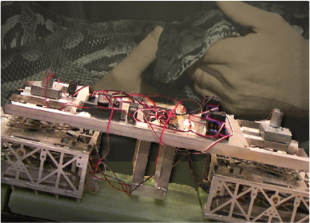Communications of the ACM
Snakes Improve Search-and-Rescue Robots

Snakes inspired Georgia Tech researchers' strategies for robotic locomotion.
Credit: Bi-State Wildlife Hotline of Missouri & Illinois
Designing an all-terrain robot for search-and-rescue missions is an arduous task for scientists. The machine must be flexible enough to move over uneven surfaces, yet not so big that it's restricted from tight spaces. It might also be required to climb slopes of varying inclines. Existing robots can do many of these things, but the majority require large amounts of energy and are prone to overheating. Georgia Tech researchers have designed a new machine by studying the locomotion of a certain type of flexible, efficient animal.
"By using their scales to control frictional properties, snakes are able to move large distances while exerting very little energy," says Hamid Marvi, a Mechanical Engineering Ph.D. candidate at Georgia Tech.
While studying and videotaping the movements of 20 different species at Zoo Atlanta, Marvi developed Scalybot 2, a robot that replicates rectilinear locomotion of snakes. He unveiled the robot earlier this month at the Society for Integrative & Comparative Biology annual meeting in Charleston, S.C.
 The two-link Scalybot 2 robot is controlled by a remote-controlled joystick and can move forward and backwardusing four motors.Credit: Georgia Institute of Technology The two-link Scalybot 2 robot is controlled by a remote-controlled joystick and can move forward and backwardusing four motors.Credit: Georgia Institute of Technology |
Scalybot 2 can automatically change the angle of its scales when it encounters different terrains and slopes. This adjustment allows the robot to either fight or generate friction. The two-link robot is controlled by a remote-controlled joystick and can move forward and backward using four motors.
View a video of Hamid Marvi describing his work and observing snakes at Zoo Atlanta.
"Snakes are highly maligned creatures," says Joe Mendelson, curator of herpetology at Zoo Atlanta. "I really like that Hamid's research is showing the public that snakes can help people."
Marvi's advisor is David Hu, an assistant professor in the Schools of Mechanical Engineering and Biology. Hu and his research team are primarily focused on animal locomotion. They've studied how dogs and other animals shake water off their bodies and how mosquitos fly through rainstorms.
This isn't the first time Hu's lab has looked at snake locomotion. Last summer the team developed Scalybot 1, a two-link climbing robot that replicates concertina locomotion. The push-and-pull, accordion-style movement features alternating scale activity.
This project is supported by the U.S. National Science Foundation Award No. PHY-0848894.
No entries found